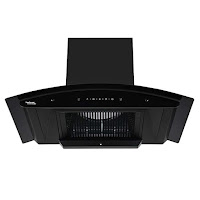Chimney for kitchen
The Essential Guide to Choosing the Perfect Chimney for Your Kitchen
In the modern culinary landscape, the kitchen has evolved from being a functional space to a hub of creativity and innovation.
As cooking techniques and styles have advanced, so have the appliances that support them. One such crucial appliance is the kitchen chimney. A well-designed chimney not only enhances the aesthetics of your kitchen but also plays a pivotal role in maintaining a clean and healthy cooking environment. In this comprehensive guide, we will delve into the world of kitchen chimneys, discussing their benefits, types, features, installation, and maintenance. So, let's explore how to choose the perfect chimney for your kitchen!
Benefits of a Kitchen Chimney:
Before diving into the specifics, it's essential to understand why a kitchen chimney is a must-have in today's culinary spaces. The primary function of a chimney is to eliminate smoke, odors, grease, and steam that are generated during cooking. This not only keeps the air in your kitchen fresh but also prevents the buildup of grime on your walls, ceilings, and cabinets. Here are some key benefits of installing a kitchen chimney:
Improved Air Quality: Cooking releases various pollutants and gases that can be harmful if inhaled. A chimney efficiently removes these pollutants, ensuring the air you breathe while cooking is clean and healthy.
Odor Removal: Strong cooking smells can linger in your home for hours or even days. A chimney helps eliminate these odors, leaving your kitchen and home smelling fresh.
Grease Control: Grease particles released during cooking can settle on surfaces, leading to stubborn stains and an unclean appearance. A chimney prevents this by capturing grease and preventing it from spreading.
Reduced Cleaning Efforts: With a chimney in place, you'll notice a significant reduction in the amount of cleaning required to maintain your kitchen. Walls, tiles, and cabinets will remain cleaner for longer periods.
Types of Kitchen Chimneys:
Chimneys come in various types, each catering to different kitchen setups and requirements. The two primary categories are:
Ducted Chimneys:
Also known as vented chimneys, these models expel the smoke and odors outside through a duct.
Ducted chimneys are highly effective in removing pollutants, making them an ideal choice for heavy cooking.
Ductless Chimneys: Ductless chimneys, also called recirculating chimneys, use filters to trap grease and odors before releasing the cleaned air back into the kitchen. While they are easier to install, they are generally less efficient than ducted chimneys.
Key Features to Consider:When selecting a chimney for your kitchen, several features should influence your decision:
Suction Power: Measured in cubic meters per hour (m³/hr), suction power indicates how effectively a chimney can eliminate smoke and odors. Choose a chimney with sufficient suction power based on the size of your kitchen.
Size and Design: The chimney's size and design should complement your kitchen's layout and aesthetics. Chimneys come in various styles, such as wall-mounted, island, and built-in, so select one that suits your space.
Filters: The type of filter used in the chimney plays a crucial role in its performance. Baffle filters are effective at capturing grease, while charcoal filters help remove odors. Maintenance frequency varies with the filter type.
Noise Level: Chimneys can generate noise while operating. Look for models with lower noise levels, especially if you have an open-concept kitchen.
Controls and Lighting: Chimneys come with different control options, including touch controls and push buttons. Additionally, many models feature built-in lighting to illuminate your cooking area.
Installation and Maintenance:
Proper installation and regular maintenance are vital to ensuring the optimal functioning of your kitchen chimney:
Professional Installation: Always have your chimney installed by a trained professional. Proper installation ensures efficient performance and minimizes the risk of accidents.
2.Regular Cleaning: Clean the filters regularly, as clogged filters can affect suction power and overall efficiency. Baffle filters can be washed, while charcoal filters need replacement.
Duct Cleaning: If you have a ducted chimney, ensure that the ductwork is cleaned periodically to prevent blockages.
Annual Servicing: Schedule an annual maintenance service with a professional to inspect and clean the chimney thoroughly.
Conclusion:
A kitchen chimney is not just a functional appliance; it's an investment in the health and hygiene of your cooking space. By choosing the right chimney for your kitchen's needs and maintaining it properly, you can enjoy a clean, odor-free, and aesthetically pleasing environment while cooking. Remember to consider factors such as suction power, filter type, and design when selecting a chimney. Whether you're a passionate home cook or a professional chef, a well-chosen kitchen chimney is your key to a delightful culinary journey.





No comments:
Post a Comment